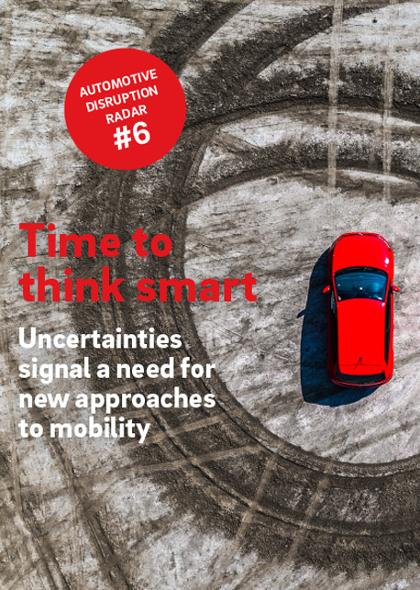automotive-disruption-radar.com


Automotive Disruption Radar: Growing despite the downturn
To remain successful, OEMs must find smarter ways to run their businesses
"The automotive industry has the opportunity to realign its mobility approach – and use the downturn as an opportunity. "
The automotive industry is currently experiencing a downturn. Although this may sound unpleasant, it can certainly be seen as an opportunity. The most important players now have the chance to realign their mobility approach in order to concentrate more on the changing needs of their customers – and therefore look ahead. The sixth issue of "Automotive Disruption Radar” (ADR 6), a biannual Roland Berger survey of the automotive industry, looks at the opportunities created by the downturn.
With traditional car manufacturers under pressure and mobility services losing money, those who want to succeed must now find other ways to run their businesses. To put it plainly, companies in the automotive industry – OEMs and service providers alike – need to develop smarter business models and offerings to take account of changing mobility trends. And it appears, autonomous driving and electric mobility are key elements in the way to go forward (Read more about automotive trends here ).
Against the downturn
The current weakness of the market offers traditional industry participants the opportunity to catch up in areas such as battery technology or the improvement of the interface to technology giants. This could support margins in the difficult times ahead. ADR 6 provides some good news: The number of respondents considering buying an electric car as their next vehicle has increased from 35% to 40% compared to the results presented in ADR 5. No wonder then that sales of electric cars rose against the trend of the downturn, with a slight increase from 2.6% in 2018 to 2.9% in the first half of 2019.
Electric vehicles are particularly popular in Sweden and the Netherlands, and they are also gaining ground in other countries, especially China. Another decisive factor could be the increase in tightening emission regulations in city centers, limiting the use of combustion engines. However, the measures go even further: For example, the city council of Minneapolis, USA, has banned the opening of new drive-in windows in fast food restaurants, to reduce idling engine fumes and improve air quality.
Autonomous driving on the rise
E-vehicles are one trend; the other is autonomous driving. In ADR 5, Roland Berger described the hunt for more intelligent algorithms that require less computing power as one of the last big technical hurdles to fully autonomous driving. Since then, not only have new technologies emerged (such as computer chips), but the acceptance of the technology is also increasing: 55% of respondents for the ADR 6 said they would use a Robocab service, a taxi service with self-propelled cars.
Another result of ADR 6 is that venture capital investment in artificial intelligence (AI) – known to be a key factor for autonomous driving – has increased by more than 32% year-on-year to $6.2 billion. This suggests that investment has not yet peaked despite the downturn in the automotive industry. Furthermore, in the last two years, the number of new regulations for autonomous driving has increased considerably, which is crucial for mass introduction. South Korea, for example, passed its Autonomous Vehicle Act in April 2019, which sets safety standards and introduces a new insurance system. These and other developments show that autonomous driving is on the rise. To be continued.
About the ADR
The Automotive Disruption Radar is a biannual analysis of market trends related to disruption in the global automotive industry. Its latest findings are based on field research and a survey of 16,000 car users across 17 markets (Bahrain, Belgium, China, UAE (Dubai), France, Germany, India, Italy, Japan, the Netherlands, Russia, Singapore, South Korea, Spain, Sweden, UK, USA). ADR 6’s 26 indicators are grouped into five dimensions: customer interest, regulation, technology, infrastructure and industry activities.
To get the in-depth version of the study register for the automotive insider updates below.






